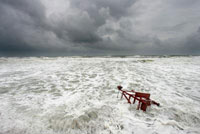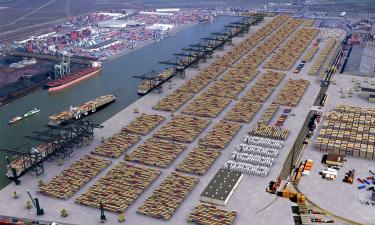Carribean hurricane Noel kills 115 people
A mighty storm rages at the Bahamas and Cuba. Using boats and helicopters, rescue workers in the Dominican Republic try to save people from communities isolated by flood. 115 people perished.

Click here to see photos
Noel was upgraded to a hurricane Thursday evening. But it did most of its damage as a tropical storm as it became the year's deadliest tempest in the Atlantic region. Hurricane Felix, a devastating Category 5 storm, killed 101 people when it lashed the Caribbean and slammed into the Nicaraguan and Honduran coasts in early September.
Hurricane Noel's sustained winds had increased to 80 mph (129 kph) late Thursday night as it moved away from the Bahamas, the National Weather Service said.
Earlier Thursday, muddy rain-swollen waters overflowed a dam in Cuba, washing into hundreds of homes, over highways and knocking out electricity and telephone service. Dozens of small communities were cut off.
Cuban soldiers went door-to-door in low-lying areas and evacuated about 24,000 people, according to state radio and television reports. At least 2,000 homes were damaged by flood waters, but there was no official word of deaths.
In Ciego de Avila province in central Cuba, flooding wiped out nearly 2,000 tons of corn, potato, banana, cucumber and tomato harvests, said Jose Ramon Machado Ventura, a vice president.
The storm brought a record 15 inches of rain to the Bahamas, Prime Minister Hubert Ingraham said. Flooding killed at least one man in the Bahamas and forced the evacuation of almost 400 people. Ingraham said the majority of the evacuees were from the northeast Bahamian island of Abaco.
Residents of Andros Island, one of the least-developed in the Bahamas, hunkered down as Noel's winds howled and rain pelted windowpanes.
"The walls were rattling, but we rode it out pretty well," said Angela Newton, who was waiting Thursday for the power to come back on.
Electricity also was turned off in Long Island, in the southeastern part of the Atlantic archipelago.
Nassau International Airport closed but was expected to reopen Friday. Only one of 10 cruise ships arrived on schedule.
Rescuers in Dominican Republic took off in helicopters and boats to reach isolated residents for the first time in three days. Hundreds of volunteers joined Dominican civil defense forces to help stranded residents, as rescue teams left at dawn Thursday - many in boats loaned by private owners.
"We will go to each point where there have been people affected who require the government's help ...

On the southeastern Dominican coast, the U.S. Coast Guard was helping to free a Liberian gas carrier that broke loose from its moorings and ran aground on a reef. The 551-foot (168-meter) SCF Tomsk is carrying 1.9 million gallons (7.2 million liters) of oil but is not leaking, according to a statement from the guard.
More than three days of heavy rain caused an estimated US$30 million (EUR 21 million) in damages to the Dominican Republic's rice, plantain and cacao plantations, said Minister of Economy Juan Temistocles Montas. Government officials will request loans from the Inter-American Development Bank to help with the recovery.
Rescuers in Hispaniola, the island shared by the Dominican Republic and Haiti, found a rising toll of death and damage: at least 73 dead in the Dominican Republic and 40 in Haiti, where the majority of bodies were found in and around the capital of Port-au-Prince. One person was killed in Jamaica.
Fernandez declared a state of emergency and asked for international help, especially rescue teams and helicopters.
At least 62,500 Dominicans fled their homes, said Luis Antonio Luna, head of the Emergencies Commission.
In Haiti, civil protection crews confirmed 16 more deaths, boosting the national toll to 40, said Marie Alta Jean-Baptiste, director of Haiti's civil protection agency.
At 11 p.m. EDT (0300 GMT), the hurricane's center was about 180 miles (290 kilometers) north-northeast of Nassau, or 760 miles (1,225 kilometers) west-southwest of Bermuda, according to U.S. forecasters. It was moving north-northeast around 20 mph (32 kph).
A tropical storm warning and watch for parts of southeastern Florida were canceled and officials said coastal communities from the Georgia border south to Miami were largely spared major damage.
But several dozen structures up and down the Florida coast were threatened. In St. Johns County , at least a half dozen homes were in danger after beaches washed away, leaving little barrier between them and the waves.
The city of Fernandina Beach near the Georgia border declared a local emergency Wednesday, and waves continued Thursday lapping at the foundations of several homes and at least one motel in Brevard County .
Only "isolated instances" of damage were reported statewide, said Mike Stone of the Florida Division of Emergency Management.
"The primary effect is some coastal erosion and some flooding issues, but we don't have any other real big concerns," Stone said.
Over the next 24 hours, Noel was expected to become an extratropical storm, which gets its energy from the collision of warm and cold fronts, not the steamy ocean waters that tropical systems feed on.
Subscribe to Pravda.Ru Telegram channel, Facebook, RSS!





